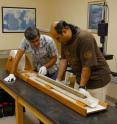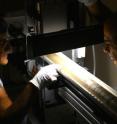Study finds abrupt climate change may have rocked the cradle of civilization
Related images
(click to enlarge)
New research reveals that some of the earliest civilizations in the Middle East and the Fertile Crescent may have been affected by abrupt climate change. These findings show that while socio-economic factors were traditionally considered to shape ancient human societies in this region, the influence of abrupt climate change should not be underestimated. A team of international scientists led by researchers from the University of Miami (UM) Rosenstiel School of Marine and Atmospheric Science found that during the first half of the last interglacial period known as the Holocene epoch, which began about 12,000 years ago and continues today, the Middle East most likely experienced wetter conditions in comparison with the last 6,000 years, when the conditions were drier and dustier.
"Evidence for wet early Holocene was previously found in the Eastern Mediterranean Sea region, North and East African lakes and cave deposits from Southwest Asia, and attributed to higher solar insolation during this period," said Ali Pourmand, assistant professor of marine geosciences at the UM Rosenstiel School, who supervised the project. "Our study, however, is the first of its kind from the interior of West Asia and unique in its resolution and multi-proxy approach."
The Fertile Crescent, a region in west Asia that extends from Iran and the Arabian Peninsula to the eastern Mediterranean Sea and northern Egypt is one of the most climatically dynamic regions in the world and is widely considered the birthplace of early human civilizations.
"The high-resolution nature of this record afforded us the rare opportunity to examine the influence of abrupt climate change on early human societies. We see that transitions in several major civilizations across this region, as evidenced by the available historical and archeological records, coincided with episodes of high atmospheric dust; higher fluxes of dust are attributed to drier conditions across the region over the last 5,000 years," said Arash Sharifi, Ph.D. candidate at the department of marine geosciences and the lead author of the study.
The researchers investigated climate variability and changes in paleoenvironmental conditions during the last 13,000 years based on a high-resolution (sub-decadal to centennial) peat record from Neor Lake in Northwest Iran. Abrupt climate changes occur in the span of years to decades.
Source: University of Miami Rosenstiel School of Marine & Atmospheric Science
Articles on the same topic
- Mammoths killed by abrupt climate changeThu, 23 Jul 2015, 23:03:46 UTC
- What killed off the megafauna?Thu, 23 Jul 2015, 23:03:35 UTC
Other sources
- Mammoths killed by abrupt climate changefrom Science DailyThu, 23 Jul 2015, 23:00:14 UTC
- Mighty Mammoths Fell Prey to Rapidly Warming Earthfrom Live ScienceThu, 23 Jul 2015, 22:30:09 UTC
- Abrupt climate change killed off mammothsfrom UPIThu, 23 Jul 2015, 22:00:13 UTC
- Study finds abrupt climate change may have rocked the cradle of civilizationfrom PhysorgThu, 23 Jul 2015, 20:30:22 UTC
- Sudden heat spikes did in Ice Age’s mammoth mammalsfrom Sciencenews.orgThu, 23 Jul 2015, 18:50:05 UTC
- Hot spells doomed the mammothsfrom Science NOWThu, 23 Jul 2015, 18:40:07 UTC
- Mammoths Killed by Abrupt Climate Changefrom Newswise - ScinewsThu, 23 Jul 2015, 18:30:15 UTC
- Mammoths killed by abrupt climate changefrom PhysorgThu, 23 Jul 2015, 18:00:32 UTC


